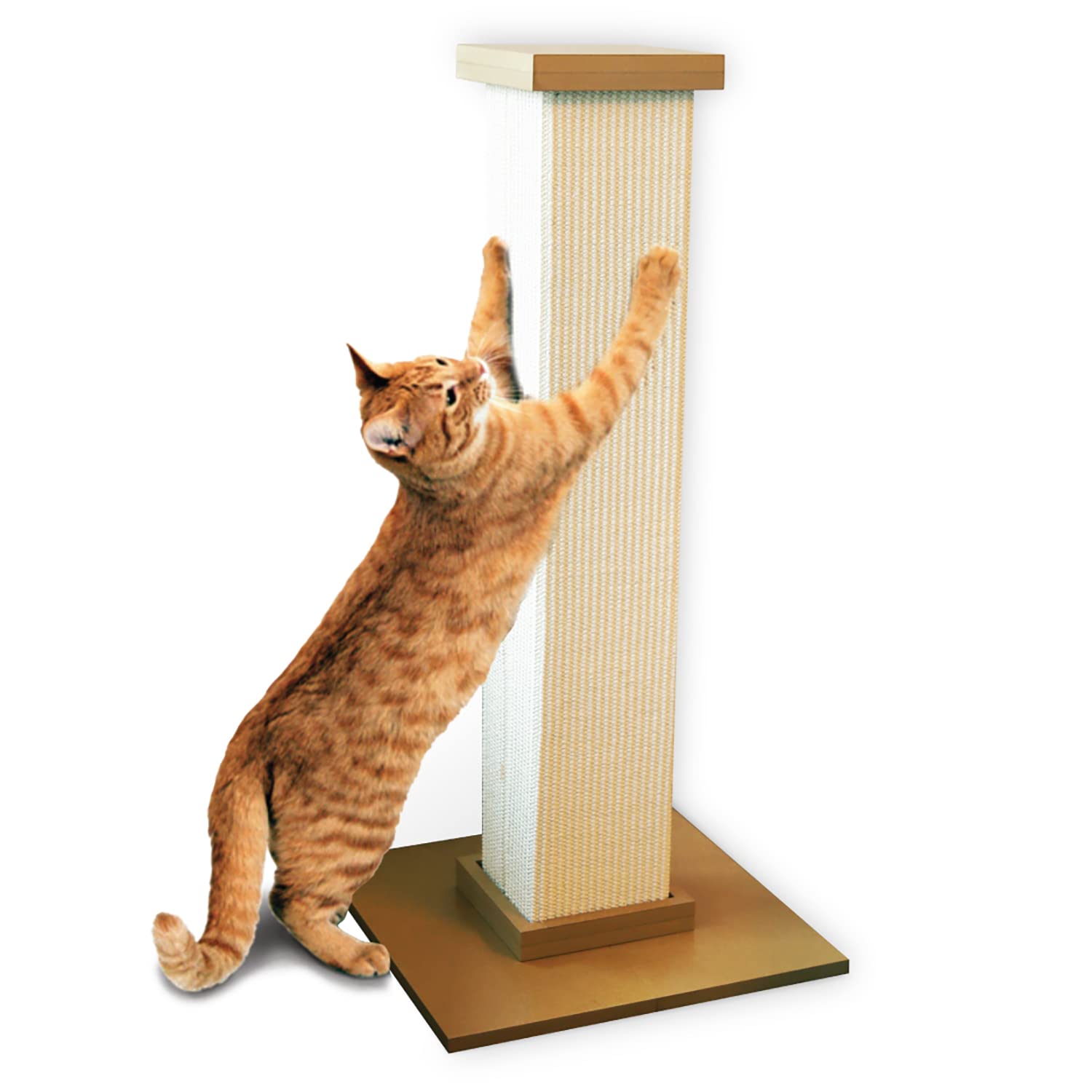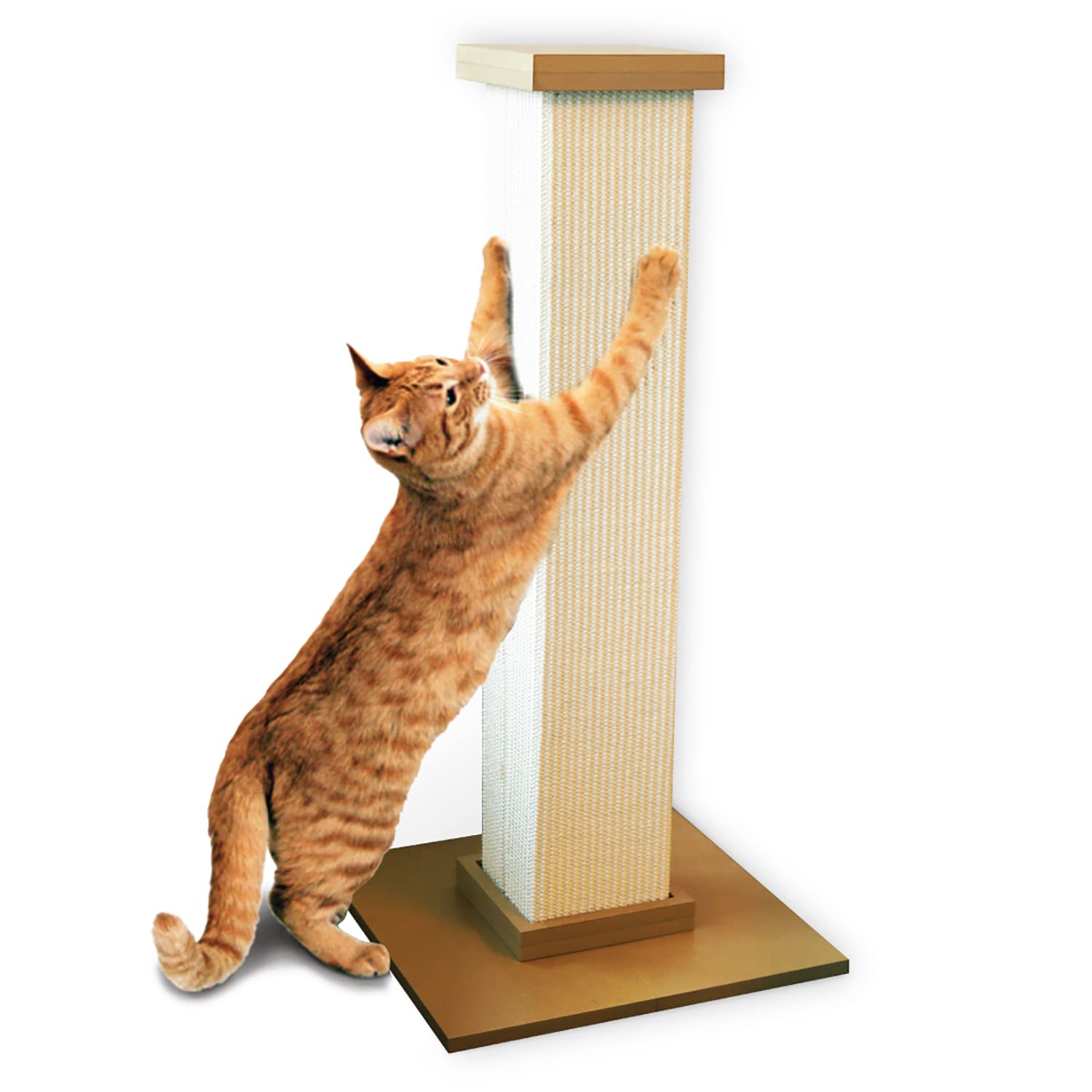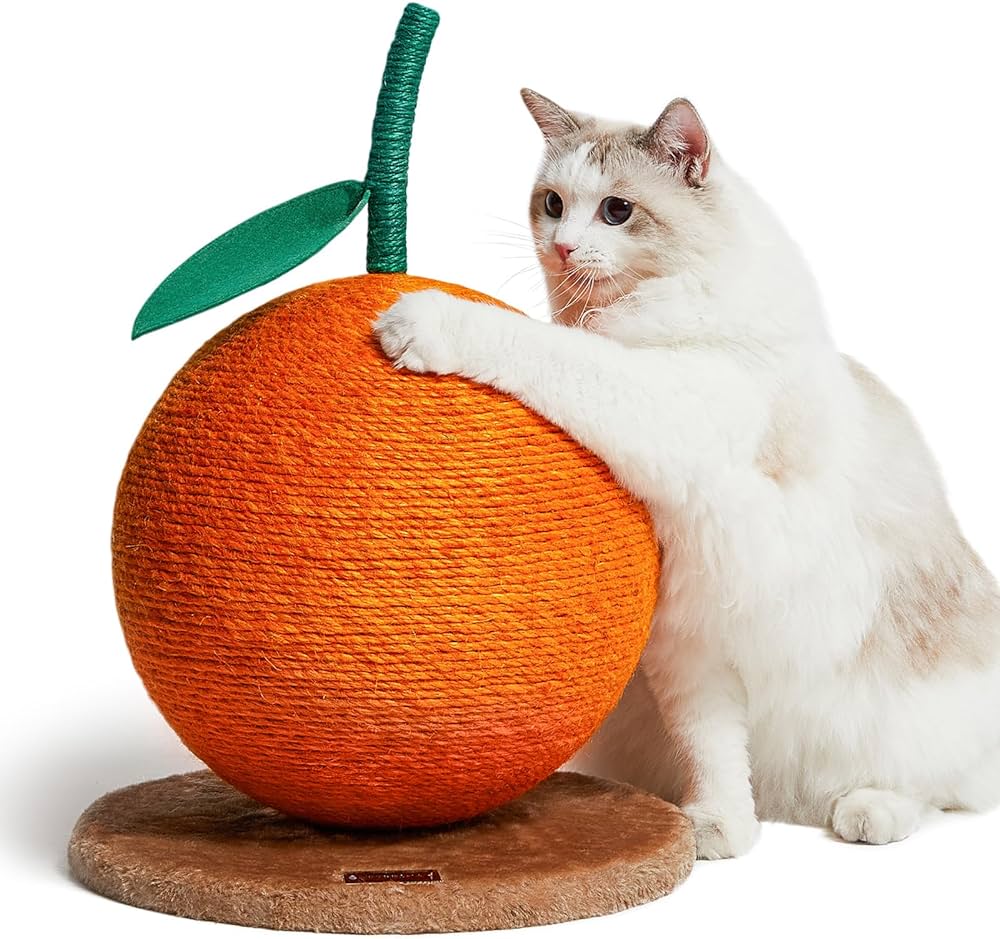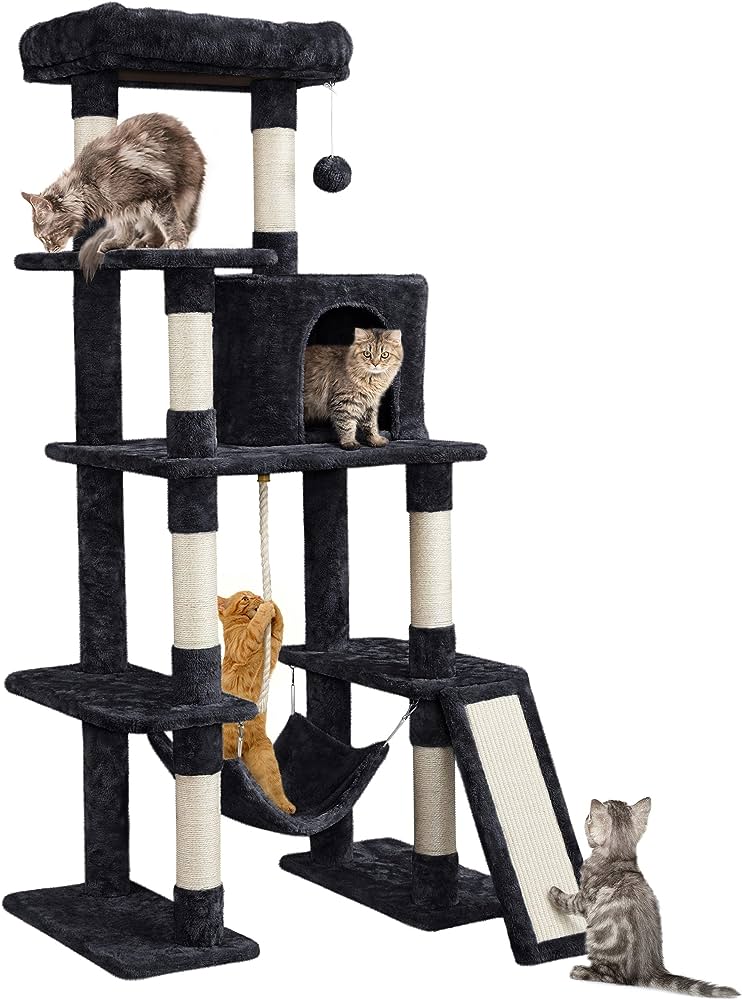To clean a cat scratching post, remove loose strands and vacuum thoroughly. Target any stains with a gentle detergent and warm water.
Maintaining a clean cat scratching post is essential for the health and happiness of your feline friend. Cats are drawn to scratching posts to exercise, mark territory, and shed old claw sheaths. Over time, these posts can accumulate cat hair, dander, and the occasional stain.
Regular cleaning helps prevent the buildup of allergens and bacteria, ensuring that your pet’s favorite scratching surface is safe and inviting. Keeping your cat’s scratching post clean also contributes to a more hygienic home environment for you and your family. It’s a simple and necessary aspect of pet care that promotes a long-lasting, enjoyable scratching experience for your cat.
Introduction To Cat Scratching Post Maintenance
Just like your feline friend, cat scratching posts need attention too. Regular maintenance of a cat scratching post is essential. It keeps the post clean and ensures it’s always appealing for your kitty to use. A well-maintained post can prevent your cat from turning to furniture as an alternative. Let’s delve into the importance and challenges of keeping your cat’s favorite furniture tidy and functional.
Importance Of Keeping Scratching Posts Clean
Your cat’s health and happiness often hinge on the cleanliness of its environment. Clean scratching posts prevent the buildup of dirt and germs. They also minimize the spread of odors and potential allergens. Here are a few key reasons for regular cleaning:
- Remove Shed Fur: Cat posts can collect a lot of fur over time. Cleaning removes this fur.
- Avoid Germ Spread: Cats scratch to mark territory which means their paws leave behind more than just claw marks.
- Extend Post Life: Regular maintenance increases a scratching post’s lifespan, making it a worthy investment.
Frequent Challenges In Cleaning Scratching Posts
Cleaning a cat scratching post can be challenging. Different materials require different cleaning methods. Some may not handle moisture well, while others can trap dirt and debris. Consider these common challenges:
| Material | Challenge | Solution |
|---|---|---|
| Sisal | Hard to vacuum | Use a stiff brush |
| Carpet | Collects hair and dust | Spot clean with soap |
| Wood | Can absorb odors | Wipe with a damp cloth |
Each material might need a unique approach, but with the right techniques, all can be kept clean. Stay tuned for detailed steps to tackle each of these challenges!
Identifying The Material Of Your Scratching Post
Cats love a good scratch, and choosing the right type of scratching post is crucial for their claw health and your furniture’s longevity. Knowing what material makes up your cat’s favorite scratcher can influence its durability, effectiveness, and ease of cleaning. Let’s unravel the fabric and textures that could be wrapped around that pillar of claw-sharpening fun.
Common Materials Used In Scratching Posts
- Sisal Fabric: Highly durable and rough, perfect for intense scratching.
- Sisal Rope: Twisted tough fibers, great for resilient scratch needs.
- Carpet: Soft and familiar, often matches home decor.
- Cardboard: Lightweight and affordable, with an appealing texture for cats.
- Wood: Solid and long-lasting, gives a natural surface to scratch.
Benefits And Drawbacks Of Different Materials
| Material | Benefits | Drawbacks |
|---|---|---|
| Sisal Fabric | Resist shredding, long lifespan | Can be rough on paws |
| Sisal Rope | Strong, good for claw maintenance | Loose strands may occur over time |
| Carpet | Soft, familiar to cats | May fray, harder to clean |
| Cardboard | Lightweight, enjoyable for cats | Shorter lifespan, may leave debris |
| Wood | Lasts long, no fraying | Less popular with some cats, splinter risk |
Material choice directly impacts how you’ll approach cleaning. For sisal fabric and rope, a stiff brush and light vacuuming work wonders. With carpet, regular vacuuming is key, and for wooden posts, a simple wipe down suffices. Cardboard may require frequent replacements to stay fresh and clean. Identifying your scratching post material sets you on the path to a proper and efficient cleaning routine that will help extend its life and keep your cat happy.
Basic Cleaning Techniques
Your cat’s favorite scratching post is a haven for fun, but also a magnet for fur and dirt. Regular cleaning keeps it inviting and extends its life. Basic cleaning techniques are easy yet effective in maintaining your feline friend’s go-to spot. Let’s explore how to keep your scratching post looking like new.
Vacuuming Loose Debris
Vacuuming is the first step in the cleaning process. It removes hair, dust, and other loose particles. Use a vacuum attachment designed for upholstery. Gently run it over the entire surface of the scratching post. Pay extra attention to crevices where debris may collect. This ensures your scratcher is free of loose dirt before proceeding to spot cleaning.
Simple Spot Cleaning Methods
For minor stains, spot cleaning is your go-to method. Mix a small amount of mild detergent with water. Dab this solution onto the spots using a clean cloth. Rub gently to avoid damaging the material. Rinse with a damp cloth and let the area air dry. Avoid harsh chemicals to protect your cat’s health and the integrity of the post.

Credit: www.amazon.com
Deep Cleaning Solutions
A deep cleaning solution for your cat’s scratching post is essential to maintain hygiene and ensure it remains a safe place for play and scratching. Over time, the scratching post may harbor odors, grime, and allergens. Tackle these issues with both natural and commercial cleaners tailored for your pet’s safety. Regular maintenance helps extend the life of the post and keeps your cat happy.
Diy Natural Cleaning Mixes
Find peace of mind with DIY natural cleaning mixes that are free from harmful chemicals. These homemade solutions protect your pet’s health and the environment.
- Vinegar and Water: A 50/50 mixture that neutralizes odors.
- Baking Soda: Sprinkle it on, let sit, then vacuum for freshness.
- Lemon Juice: Adds a fresh scent and has antimicrobial properties.
Apply these mixes with a spray bottle or cloth. Ensure to test on an inconspicuous area first. Allow the post to dry completely before allowing your cat to use it.
Commercial Cleaners Safe For Cats
Safe commercial cleaners designed for pets offer convenience without compromising safety. Look for labels that state ‘pet-friendly’ or ‘natural ingredients.’
| Brand | Active Ingredient | Safety Note |
|---|---|---|
| Eco-Me Natural Multi-Surface Cleaner | Plant Extracts | Free from synthetic fragrances |
| Puracy Natural All-Purpose Cleaner | Plant-based Enzymes | Non-toxic and biodegradable |
Ensure you follow the manufacturer’s instructions. Keep the area ventilated during cleaning. Always wait until the post is fully dry before your cat resumes use.
Maintaining And Restoring Your Scratching Post
Cat scratching posts are essential for your feline friend’s well-being. Not only do they keep your cat’s claws healthy, but they also protect your furniture from potential damage. Given their importance, it’s crucial to ensure your scratching post is always in top condition. Let’s explore how to maintain and restore your scratching post, so it remains an enjoyable spot for your kitty to stretch and scratch.
Regular Maintenance Tips
- Vacuum the post weekly to remove loose fur and debris.
- Trim loose threads to prevent your cat from pulling out strings.
- Rotate the post regularly to spread the wear evenly.
Repairing And Replacing Worn-out Parts
- Identify areas that show signs of heavy wear.
- Replace sisal rope or fabric if it becomes too frayed.
- Secure any loose parts with strong, pet-safe adhesive.
| Action | Frequency |
|---|---|
| Vacuuming | Weekly |
| Trimming Loose Threads | Monthly |
| Rope or Fabric Replacement | As Needed |
:max_bytes(150000):strip_icc()/SPRPETS-SmartCat-The-Ultimate-Scratching-Post-Sisal-Standalone-Maddy-Newton-Brooke-Kane-photo-07-2c8892887fe748f4ae9a4da742d292ef.jpg)
Credit: www.thesprucepets.com
Prevention Strategies For Future Messes
If you’re a cat owner, you know that keeping a cat scratching post clean can be a challenge. Fortunately, with the right prevention strategies, you can maintain a fresh and tidy scratching area for your feline friend. Let’s explore how to keep future messes at bay.
Training Your Cat For Cleanliness
Cats can learn good habits, including keeping their scratching post clean. Start training early when they’re most receptive. Regularly clean the post to encourage a clean environment. Use positive reinforcement like treats or praise to reward your cat. Redirect them to the scratching post if they start scratching elsewhere. Always be consistent with your commands and rewards.
- Introduce the post early
- Model good behavior
- Use rewards for correct use
Protective Covers And Their Use
Protective covers are a great way to keep your cat’s scratching post cleaner for longer. Choose covers made of easily washable materials. They should fit snugly over the scratching post. Opt for a color that hides marks and dirt well. Swap out and wash the covers regularly to maintain cleanliness and reduce wear on the post itself.
| Protective Cover Feature | Benefits |
|---|---|
| Machine washable | Makes cleaning simple and efficient |
| Snug fit | Prevents slipping and excess wear |
| Durable material | Withstands sharp claws and biting |
| Neutral color | Hides stains and marks effectively |
:max_bytes(150000):strip_icc()/diy-scratching-post-21-2000-162e32f8dc354f94b80c4fe7ab63f475.jpg)
Credit: www.dailypaws.com
Frequently Asked Questions Of How To Clean Cat Scratching Post
Can You Vacuum A Cat Scratching Post?
Yes, you can vacuum a cat scratching post. It’s an effective method for removing surface dust and cat hair. Use a vacuum with an upholstery attachment to gently go over the post, ensuring you cover all areas, especially where your cat scratches the most.
What Cleaning Solution Is Safe For Cat Posts?
A mild dish soap and water solution is safe for cleaning cat scratching posts. Avoid harsh chemicals as they can be harmful to your cat. Gently scrub the affected areas with the solution and a soft brush, then wipe off any excess moisture with a clean cloth.
How Often Should I Clean My Cat’s Scratching Post?
Cleaning your cat’s scratching post should be done regularly, about once a month. However, if you notice visible dirt, debris, or an unpleasant odor, increase the frequency of cleaning to maintain a healthy environment for your pet.
Can I Replace The Material On A Scratching Post?
Yes, you can replace the material on a scratching post. Common materials like sisal rope and carpet can be bought from pet stores and wrapped or stapled securely around the post, giving it a fresh surface for your cat to scratch.
Conclusion
Ensuring your cat’s scratching post remains clean promotes both hygiene and happiness for your furry friend. With routine care, these staples of feline life can last longer, saving you time and money. Remember, a clean post is more inviting, making it less likely your cat will seek out other places to scratch.
The key to success lies in regular, simple maintenance. Keep your cat’s scratching post fresh, and watch them enjoy their beloved scratcher for years to come.



